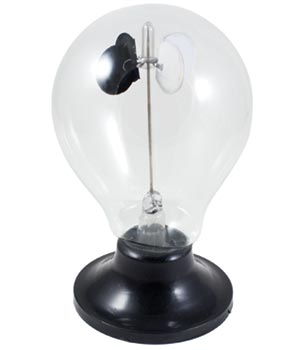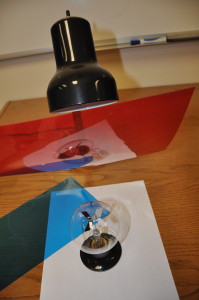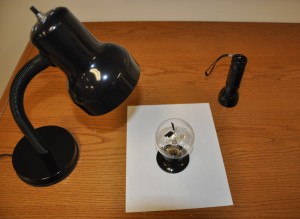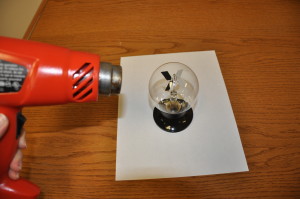 by: Tami O’Connor – Taken From Litetronics
by: Tami O’Connor – Taken From Litetronics
The radiometer is a light bulb-shaped device containing an object that looks like a weather vane (wings arranged in a circle like spokes of a wheel). Developed to measure the intensity of radiant energy, or heat, the radiometer will:
- Help you understand the principles of energy conversion.
- Show how heat and mechanical energy are products of energy conversion.
Most of us don’t realize how important energy is in our lives. In actuality, every facet of our life involves energy. One of the reasons we tend to take energy for granted is that it is constantly changing from one form to another. We call this change conversion.
During this conversion, energy is changing from one form to another. In all energy conversions, the useful energy output is less than the energy input. This is because some energy is used to do work, and some energy is converted to heat.
Sir William Crookes invented the original radiometer in the mid-nineteenth century. The device was developed to measure the intensity of radiant energy, or heat.
What causes the vanes of the radiometer to spin?
The atmosphere inside a radiometer is a nearly perfect vacuum. More than 99% of the air has been removed, leaving few air molecules inside the radiometer compared to the formerly trillions of air molecules. The “lowered density of the air” inside the radiometer means that the air molecules are able to move about more freely.
The opposing sides of each vane within the radiometer are alternately dark and light in color. As light (or infrared radiation) hits the vanes, the lighter side reflects the light while the dark side absorbs it. As the dark side absorbs the radiant energy, a difference in temperature develops between the vanes. The freely moving air molecules bounce off the dark side with added energy. As the air molecules “kick” away from the dark side of the vane, they form convection currents and momentum transfer causing the vanes to spin away from the side from which they kicked (that is away from the dark side of the vane).
Stronger light means that more energy will be absorbed on the dark side, and the air molecules will “kick off” faster and with greater force. Therefore, as the light gets brighter, the vane begins to spin faster and faster.
Fun Activities to Try With Your Radiometer
Sunlight is responsible for many things, including the production of our food. Plants use energy from the sun to drive the chemical change in the leaves of plants. Plants act as an energy converter, and they can change the light energy into chemical energy that plants use to grow.
This conversion begins with light energy that is changed into mechanical energy and heat. In all energy conversions, the form of energy changes from a more useful type to a less useful type of energy. Eventually all of the energy that we use will end up as heat, which is the least useful form of energy.
Always remember to be careful while using your radiometer. Because it is made of glass, it may break if handled roughly or dropped. If the radiometer does break, contact an adult immediately to clean the broken pieces.
Experiment #1
Materials: Flashlight, lamp with an incandescent bulb, mirror
Put you radiometer under different light sources including sunlight. Which light source makes the radiometer spin the fastest?
Experiment #2
 Does a mirror increase the intensity?
Does a mirror increase the intensity?
Use a plastic mirror to add additional light to the radiometer. Does the mirror make the vanes spin faster or slower? Why do you think that is? Try holding the mirror at different angles to add light from different directions. How does that change the rate of motion?
Experiment #3
Does the radiometer need direct sunlight?
Materials: Flashlight, lamp with an incandescent bulb, mirror, various colors of colored cellophane or colored plastic
 Your goal is to find out if the radiometer still spins when the light source has to pass through a colored cellophane or colored plastic. Use the different light sources from Experiment #3, but place the colored cellophane or plastic between the light source and the radiometer so the light has to pass through it. Do certain colors allow more light though to make the vanes spin faster? Do the vanes spin faster or slower with the colored cellophane or the colored plastic?
Your goal is to find out if the radiometer still spins when the light source has to pass through a colored cellophane or colored plastic. Use the different light sources from Experiment #3, but place the colored cellophane or plastic between the light source and the radiometer so the light has to pass through it. Do certain colors allow more light though to make the vanes spin faster? Do the vanes spin faster or slower with the colored cellophane or the colored plastic?
Experiment #4
The radiometer and heat energy.
Use a hair dryer to direct a stream of heat toward the radiometer. Do the vanes turn at all? And if so, what happens after a few seconds? How is this energy source (the hair dryer) different than light energy?
Experiment #5
Will wind affect the radiometer?
Materials: fan or drinking straw
Using the drinking straw or fan, blow air at the radiometer. Can you get it to turn? Why or why not?
Experiment #6
Your turn… Can you devise an experiment?
It is your turn to be the scientist. Now that you know about the radiometer, can you devise an experiment using it? Decide what you’re testing for and test your results!
Educational Innovations sells radiometers for $17.95.


Thanks. I’m looking forward to trying this one too.
Connie
My students loved it! It’s a great discrepant event!
Is there a printed or E compendium of all classroom experiments?
Regards
Ira.
Hello Ira,
We do not have all our classroom experiments compiled in one place on our website, but on each product page, if there is an experiment, activity or lesson plan idea, it can be easily downloaded from the lesson idea tab. I hope that helps!
Am currentlyworking on a project title microcontroller base radiometer. I just want to know the approach to the topic and what will be my basic objectives. Waiting for yoyour replreply . Thanks
Hi there. I’m not exactly sure what you’re asking. Can you be a little more specific?
Suggested radiometer demonstration:
Place the radiometer in a sink so that a gentle stream of water can be directed upon the top of the globe. Ambient light should be low enough that the vanes remain stationary.
Gently direct a stream of warm water upon the top of the radiometer such that it flows down over the globe. Observe the direction of rotation of the vanes. (They rotate as if in response to light.)
Allow the warm water to continue flowing for a minute or two. Observe the action of the vanes. (They will gradually slow and stop)
Change the temperature of the gentle stream of water from warm to cold, do not change anything else. Observe the response of the vanes. (The vanes will rotate in the direction opposite from their rotation when exposed to bright light.)
Allow the cold water to flow for a minute or two. Observe the action of the vanes. (The vanes will gradually slow and stop rotating.)
State an hypothesis to explain these observations.
Thanks for the ideas! We’ll have to give this a shot!
~Tami
Educational Innovations
For a variation on this demonstration one can use a hair dryer instead of warm and cool water.
Place the radiometer on a table in an area with reduced light. The light should be sufficient to observe the radiometer but not so intense as to cause it to respond.
Direct hot air from the hair dryer onto the radiometer bulb. It will respond as it would to bright Light, but after a short time the vanes will slow and stop rotating.
Then switch the hair dryer to blow ambient cool air onto the bulb of the radiometer. The radiometer will then respond with the Vanes rotating opposite the way they respond to light as the radiometer cools, and in a short time it will again stop rotating.
Next, direct light from an incandescent source of sufficient brightness to cause the radiometer vanes to rotate. Notice the direction of rotation and that theycontinue rotating as long as the light is directed upon them. The radiometer vanes do not stop rotating after a short time as they do in response to the heat of the hair dryer.
Develop an hypothesis to explain these observations.
my school is having a science fair and the topic is using radiometer to proof how the light that strikes on it influences the rotation speed. however they want me to correlate how this radiometer could help in todays world. i cannot find anything that can make radiometers technology lead to some invention on my own. i need some ideas. thanks
Hi Kumar,
This is a tough one. The radiometer has been around for quite a while, and it seems that there haven’t really been any new technologies developed around it since its invention. I’m thinking that asking a school student to come up with one is a rather ambitious goal. Sorry we couldn’t be more help to you. Perhaps someone who subscribes to our blogs might be better able to help.
~Tami
Educational Innovations
The Crookes radiometer has been around well over a century. It is often considered a novelty device with little practical application. It appears deceptively simple, however many different explanations have been offered to explain how it works.
I suggest that you research this topic on the internet. You will quickly discover that there is still disagreement among those who offer explanations regarding the theory of operation of the radiometer. You may find my post elsewhere on this blog of some interest in this regard.
The general consensus of contemporary opinion is that the radiometer is a type of heat engine.
The mechanical output of a Crookes radiometer is so miniscule that it appears to have no practical application as an engine. It is however a useful device for the demonstration of the relationship of electromagnetic energy and mechanical energy.
Discussion of the radiometer as a heat engine may lead your students to research other types of heat engines that may have practical output now and in the future.
The “Drinking Bird” is another common and inexpensive novelty device and is also a heat engine. It’s theory of operation is quite different from that of the radiometer and I will leave it to you to research that on your own.
Thank you very much for the responds.
oh, any time kumar!
Hello, Ms. O’Connor,
I’m a 7th grade student and am currently working on an experiment in which I must answer a few questions in order to complete the experiment. The ones I am stuck on are:
“How was the radiometer developed?” and;
“What variables can impact the speed the radiometer spins at?”
Your response will be much appreciated.
~Victoria
Hello Victoria~
I think your questions can be answered within the blog post, but also if you read the comments by Phil Schaad, he has added quite a lot of interesting information on the radiometer. Have you completed any of the activities suggested in the post? If not, I think doing so will give you some great hands-on experience to enable you to easily answer at least your second question of what variables can impact the speed at which the radiometer spins. Happy experimenting!
~Tami
Hello Ms. O Connor
I’m Alexis a 7th grade student and i am also working on a similar project as my classmate Victoria. I couldn’t find how a radiometer shows how heat and mechanical energy are products of energy conservation. And this is Only helpful website i found. I was wondering if you could help clarify my question above. Thank you for your amazing article. Your response will be appreciated.
Hi, Alexis! Energy comes in many forms, including heat, motion (kinetic), radiation, nuclear, electrical, chemical, potential (Stored elastic/ gravitational). Energy can be converted from one form to another. (i.e., chemical energy in a battery can be converted into mechanical energy in an electric motor).
Let’s apply energy conversion ideas to the radiometer in your question. From the list above, fill in the applicable form of energy in each blank below:
“________________energy in the sun is converted to ____________energy that passes through the glass bulb of the radiometer. That energy is then absorbed by the black surfaces of the vanes in the radiometer, where it is converted into _________energy, just as occurs on the black surface of a solar water heater. Gas molecules in the radiometer bulb that touch the warm black surface of each vane are sped up like a baseball which has been hit by a bat. The vanes(like the bat) rebound, converting the gas energy to ____________ energy. The vanes move!
Note….Energy conversion is not energy conservation (see your question above).
Tami O’Connor (with help from Evan Jones)
Educational Innovations
I have found this website very helpful! Thankyou for the reason why the vanes of a Crookes Radiometer spin around. i found many other reasons on other websites but none gave me a solution to my problem as well as this one did. it was detailed but also concise. thanks again, Tami! 🙂
I want to do a science fair topic on this but i am not quite sure how to measure the speed of the vanes. How did you do it?